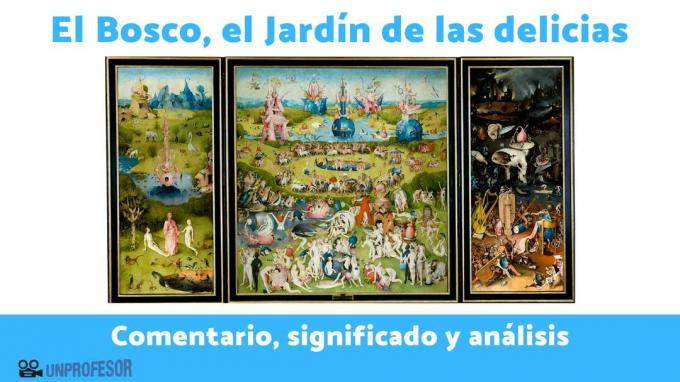Bosch, the Garden of Earthly Delights: commentary, meaning and analysis

The Garden of Earthly Delights is one of the most unique and disturbing works of art in the history of universal painting. A work signed by El Bosco, a Flemish painter from the 15th-16th century, and which is preserved and exhibited in the Prado Museum.
In this lesson from a PROFESSOR we offer you the commentary, meaning and analysis of Bosch's Garden of Earthly Delights. Discover in more detail all the keys to this masterpiece of art!
The Garden of Earthly Delights is a oil on board what is estimated was painted between 1490-1500. Its dimensions are between 205.5 x 384.9 centimeters.
This work is a triptych and, although the painting is not signed or documented, there is no doubt that The Garden of Earthly Delights is a Bosch's original painting, nickname with which he met Jheronimus van Aken (Bolduque, c. 1450-1516), also called Joen and known as Jheronimus Bosch or Hieronymus Bosch. His name is derived from the name of his hometown, which he seems to have stayed in for his entire life.
The work is from a time when Bosch's style was already formed, considering the experts that this work was executed
sometime between the late 1480s and 1500s. On the other hand, the dendrochronological study confirmed that the table was made of Baltic wood cut and dried in 1458, stored and used decades later.Bosch's style is located between medieval and renaissance, disconcerting art historians due to the medievalizing vision of the world that he offers in each of his paintings. A Flemish painter, El Bosco had a notable influence from the painters of the German school such as Schongauer, Grünewald and Albrecht Dürer, but maintaining the characteristics of provincial art: the dreamlike, the grotesque and the sarcastic. The main source of inspiration for him were the customs, legends, superstitions and sayings of the time, as well as Dutch illuminated manuscripts and medieval bestiaries.
Bosch was trained along with the rest of his family, also painters, and used to use the alla prima technique or technique of the first brushstroke in oilwith hardly any tweaks. Thus, the artist achieves a high quality and a wide range of colors with great contrast. A job that required a very detailed previous study.
You can get to know this painter better by reading this other lesson from a PROFESSOR on Bosco: most important works.

The Garden of Earthly Delights is one of the Bosch's most enigmatic works, being complex to discover what is the meaning of each one of the tables of the triptych.
He closed triptych it shows the end of the third day of Creation painted in gray. The painter represents God with a triple crown and an open book. At the top of the two tables, a Latin inscription describes the moment of Creation. Thus, the painter represents the world according to the conventions of medieval times: the earth is flat and with a large amount of water and vegetation.
He open triptych It contrasts with its color and consists of three scenes, one in each of the tables that make up the triptych:
- In the left pane, the earthly Paradise is represented, God appears in the midst of Adam and Eve. It is, therefore, the presentation of Eve to Adam, not very common in the representations of Paradise. In the medium shot, Bosch includes in the center the source of the four rivers of Paradise, on the left the dragon tree, or tree of life, and on the right the tree of the knowledge of good and evil, with the serpent coiled in the trunk.
- center panel It is populated by a large number of human figures, animals, plants and fruits. The former appear naked and in groups or pairs. The animals are real and fantastic and represented with proportions higher than normal, just like plants and fruits. It is the Garden of Earthly Delights.
- in the right pane Bosco represents Hell, highlighting the presence of numerous musical instruments, used to torture sinners. In the middle plane, the figure of the tree-man or demon stands out.
In general, Bosch represents the world delivered to sin, lust being one of the most repeated themes, although there are allusions to the deadly sins. The work has moralizing character, showing the ephemeral of pleasures, being the sin the common point in all three tables. Thus, the painter shows us:
- Human weakness in the face of temptations.
- The survival of astrology, folklore, witchcraft and alchemy.
- The eternal damnation of souls because of sin.
- Despair in the face of a world full of sin and vices.
The Garden of Earthly Delights influenced both the contemporary painters of El Bosco and the expressionist painters and the surrealist painters.
If you want to read more articles similar to Bosch, the Garden of Earthly Delights: commentary, meaning and analysis, we recommend that you enter our category of History.


1 of 2
Bosch, the Garden of Earthly Delights: commentary, meaning and analysis
